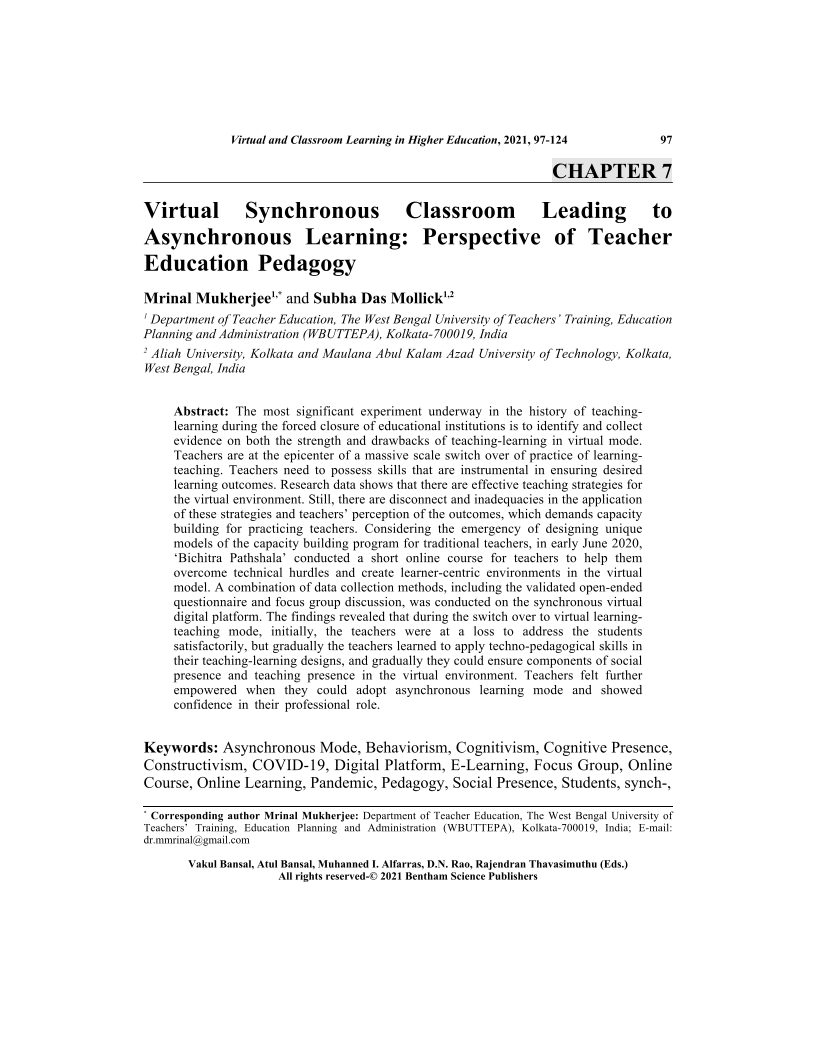Virtual Synchronous Classroom Leading to Asynchronous Learning: Perspective of Teacher Education Pedagogy

- Authors: Mrinal Mukherjee1, Subha Das Mollick2
-
View Affiliations Hide Affiliations1 Department of Teacher Education, The West Bengal University of Teachers Training, Education Planning and Administration (WBUTTEPA), Kolkata 700019, India 2 Department of Teacher Education, The West Bengal University of Teachers Training, Education Planning and Administration (WBUTTEPA), Kolkata-700019, India
- Source: Virtual and Classroom Learning in Higher Education: A Guide to Effective Online Teaching , pp 97-124
- Publication Date: December 2021
- Language: English
Virtual Synchronous Classroom Leading to Asynchronous Learning: Perspective of Teacher Education Pedagogy, Page 1 of 1
< Previous page | Next page > /docserver/preview/fulltext/9781681089287/chapter-7-1.gif
The most significant experiment underway in the history of teachinglearning during the forced closure of educational institutions is to identify and collect evidence on both the strength and drawbacks of teaching-learning in virtual mode. Teachers are at the epicenter of a massive scale switch over of practice of learningteaching. Teachers need to possess skills that are instrumental in ensuring desired learning outcomes. Research data shows that there are effective teaching strategies for the virtual environment. Still, there are disconnect and inadequacies in the application of these strategies and teachers perception of the outcomes, which demands capacity building for practicing teachers. Considering the emergency of designing unique models of the capacity building program for traditional teachers, in early June 2020, Bichitra Pathshala conducted a short online course for teachers to help them overcome technical hurdles and create learner-centric environments in the virtual model. A combination of data collection methods, including the validated open-ended questionnaire and focus group discussion, was conducted on the synchronous virtual digital platform. The findings revealed that during the switch over to virtual learningteaching mode, initially, the teachers were at a loss to address the students satisfactorily, but gradually the teachers learned to apply techno-pedagogical skills in their teaching-learning designs, and gradually they could ensure components of social presence and teaching presence in the virtual environment. Teachers felt further empowered when they could adopt asynchronous learning mode and showed confidence in their professional role.
-
From This Site
/content/books/9781681089287.chapter-7dcterms_subject,pub_keyword-contentType:Journal -contentType:Figure -contentType:Table -contentType:SupplementaryData105

